Introduction
In the first part of our analysis on Conquest's 2022 scene, we saw an analysis from the commanders' point of view, and we analyze the popularity and effectiveness of the different options.
For today's article, we will go one step further and analyze the so-called staples. Which are the most important cards in Conquest? The most used? In which strategies? Which should players look more carefully at? Which one has not worked out? These and other questions I hope to answer here.
Ad
Reminder: The data I refer to throughout the article is based on data collected from early 2022 to late December, which were compiled here, based on the biggest Conquest communities in Brazil (São Luís and, mostly, Brasília) and also in Conquest Brazil's online events.
We have had a total of 364 different commanders, 186 unique players and 69 tournaments, adding up to a total of 1037 games at the base. It is worth remembering as well that these are events without the use of proxys, so, the monetary factor is relevant when some of this data is analyzed, particularly when it comes to the popularity of certain staples.
For those who are not familiar with the Conquest format, the same was already addressed in one of Cards Realm's own article, here, from Felipe "Fells" Torres.
From this publishing until today, there were a few updates in the banlist and the addition of the Scry rule. The updated banlist and the format's rules can be seen here.
Cards by Popularity and Win Rate
Individual cards play a crucial role in shaping the metagame and determining the power level of the decks. The analysis of win rates/popularity of individual cards is based on data from 276 decklists representing 67% of all games registered and is an analysis of the presence of cards in decklists rather than an analysis of the behavior of cards in each game.
In order to be included in this analysis, a card must have appeared in at least four different decklists. This means that some less popular or niche cards may not be represented, potentially affecting the accuracy of the data.
Another important consideration is that, in general, the more popular a card is, the closer its win rate will be to the average win rate for all cards. This is due to the fact that popular cards are more likely to appear in a wider range of decks - this means there is a trend towards a "funnel shape" in the data, as in the graph below. However, there are still many cards which deviate significantly from this trend - usually the cards to be analyzed further.
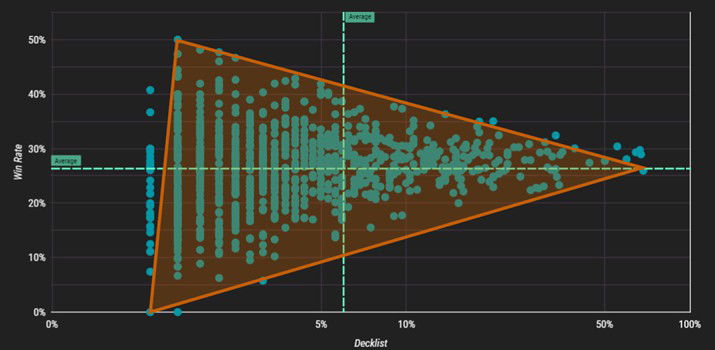
Another important factor to consider is the bias introduced by the availability of decklists. In this analysis, we only have lists for a portion of the decks that were played, and these lists tend to be skewed towards decks with higher win rates. This means that the overall average win rate for all cards in this analysis is slightly higher than it would be if we had lists for all decks, ranging from an average of 25,53% to 28,62%.
Cards - High Popularity / High Win Rate Quadrant
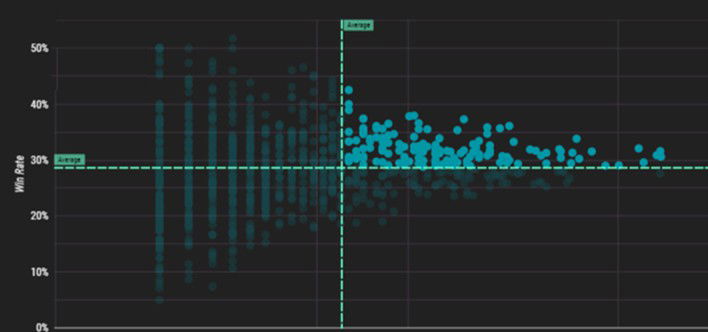
Certain cards stand out as being particularly popular and successful in Conquest: The cards that fall into High Popularity quadrant (above 6% of decklists - or above 16 different decklists) and High Win Rate (above 28,62% Win Rate) quadrant.
Ad
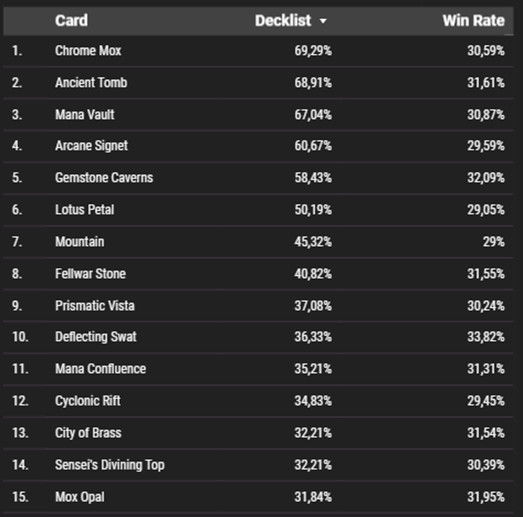
When it comes to popularity, cards in this quadrant are mainly acceleration and mana fixing. The most popular cards in this category include Chrome Mox, Mox Opal, Mana Vault, Ancient Tomb, Gemstone Caverns and Arcane Signet. Colored cards are relatively rare in this quadrant, with only Deflecting Swat and Cyclonic Rift representing Blue and Red, respectively. Curiously, tutors did not appear in the Top 15.
In terms of win rates, artifact base cards dominate this quadrant, with almost all cards within archetype falling into the High Popularity/High Win Rate category. Red is the dominant color among cards in this quadrant, with Heat Shimmer standing out as a particularly successful card, being a generic win condition for Red decks across multiple archetypes. Other notable Red cards in this quadrant include Ragavan, Nimble Pilferer, Shatterskull Smashing, Wheel of Misfortune and Pyrokinesis.
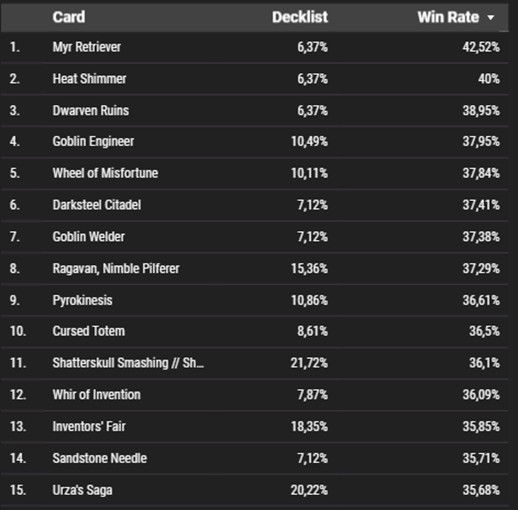
Cards - High Popularity Quadrant / Low Win Rate Quadrant
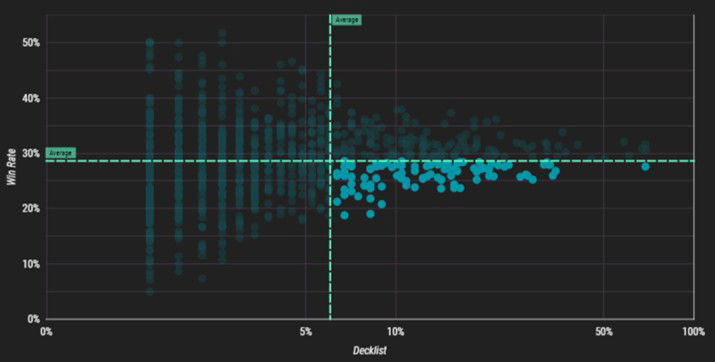
The cards that fit into the High Popularity (above 6% of different decklists) and Low Win Rate (below 26,82%) quadrant in the Conquest metagame.
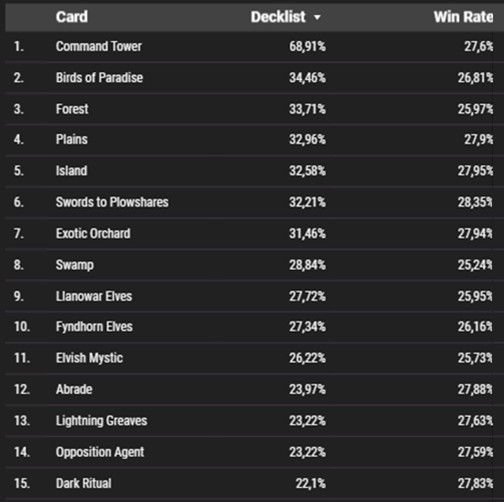
When it comes to popularity, cards in this quadrant tend to be basic lands, mana fixing and mana dorks. All basic lands, except Mountain, fit into this quadrant, as do generic and budget mana fixing options such as Command Tower and Exotic Orchard.
Mana dorks, which are cheap creatures that provide additional mana, are also popular in this quadrant, but have a below-average win rate. Surprises in this quadrant include Dark Ritual and Opposition Agent, which may be a reflection of the omnipresence of these cards in Black lists in practically all archetypes, including those who did not perform well.
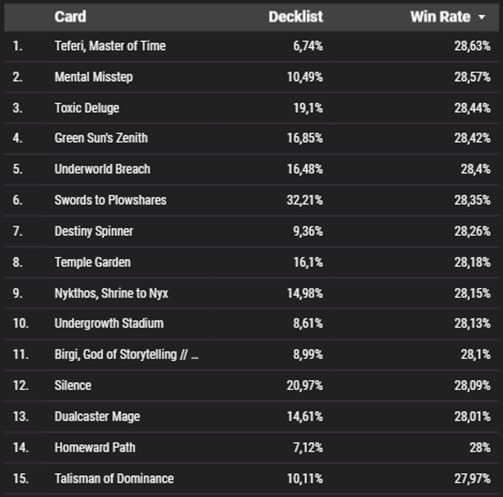
In terms of win rate, cards in this quadrant tend to be spread across a variety of cards and functions, including win conditions, interactions and mana acceleration. Green has a slightly higher presence in this quadrant, but the difference is not exaggerated. Overall, the win rate for cards in this quadrant tends to be close to the average line, with a range of results rather than a clear trend.
Cards - Low Popularity Quadrant / High Win Rate Quadrant
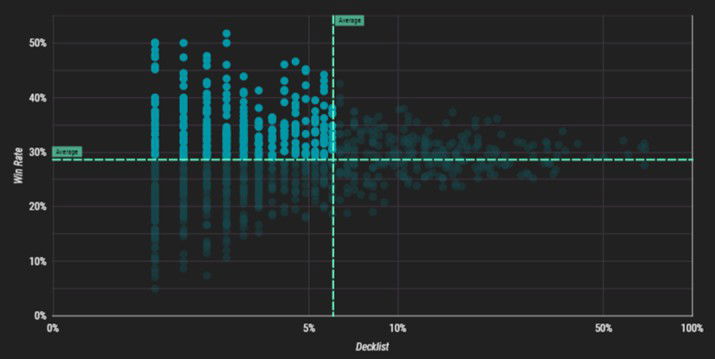
Ad
These are cards that may not be particularly popular, but have a high win rate when included in decks. The cards that fall into the low popularity have between 4 e 16 decklist appearances and win rates above 28,62%.
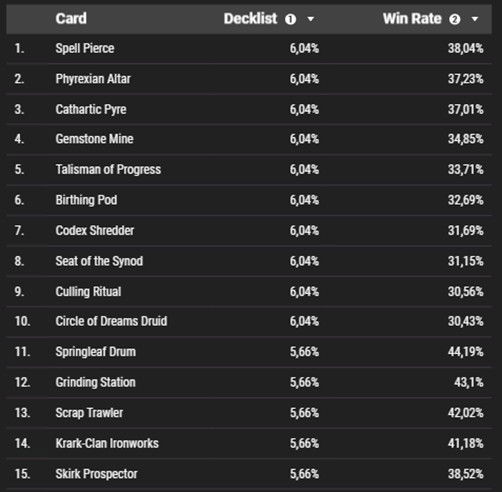
In terms of popularity, the cards in this quadrant tend to be specialized win conditions and artifact strategy cards. Some examples include Birthing Pod, Circle of Dreams Druid and Phyrexian Altar, as well as Krark-Clan Ironworks and other artifact strategy cards.
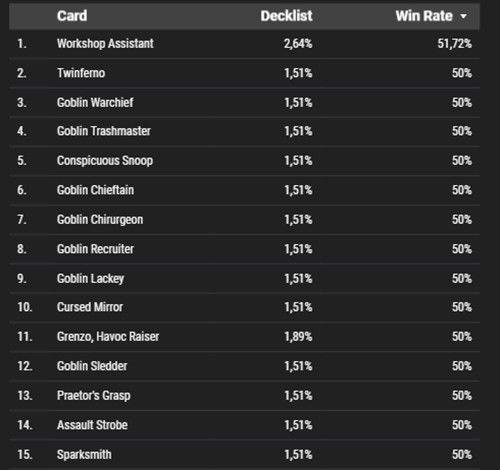
In terms of win rate, cards in this quadrant tend to be Red-based and support specific strategies. Goblins are present in Muxus, Goblin Grandee and Krenko, Tin Street Kingpin and Red dominates overall, with Twinferno and Assault Strobe serving as support card for Voltron strategies. The outlier in this list is Praetor's Grasp, which is a powerful but niche card that can support a variety of strategies.
Staples by Color
White Cards
The White Cards pool had a total of 409 different cards in this color.
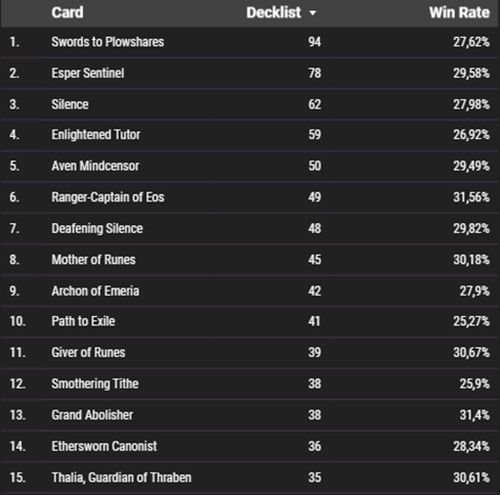
As we can see, one of the most popular strategies that utilizes white cards is the Hatebears archetype – based on disruptive creatures to disrupt the opponent's game plan –highlights go to cards with effects similar to Rule of Law (represented here by Deafening Silence, Archon of Emeria and Thalia, Guardian of Thraben.
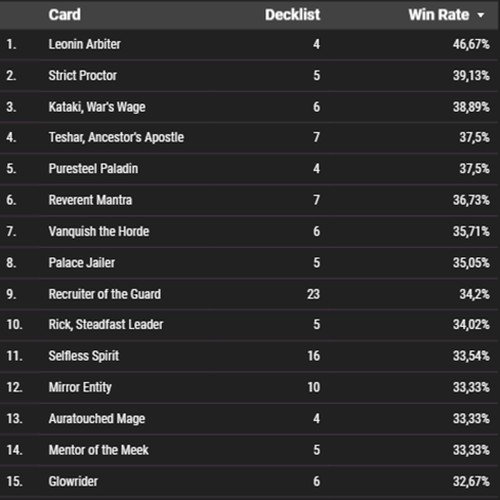
When it comes to the win rates of individual cards, the data shows that the white cards that perform the best include strategies centered around the highest number of Hatebears, so as a result some of these creatures appear ahead other popular ones when we look through the win rate prism.
A greater density of these creatures is apparently better than a smaller density. It is the case of Leonin Arbiter, Strict Proctor, Kataki, War’s Wage and Glowrider, besides other support cards for this strategy. It is worth noting that Winota, Joiner of Forces decks also boost these cards' win rates, as well as others' such as Rick, Steadfast Leader, Mirror Entity and Auratouched Mage.
Blue Cards
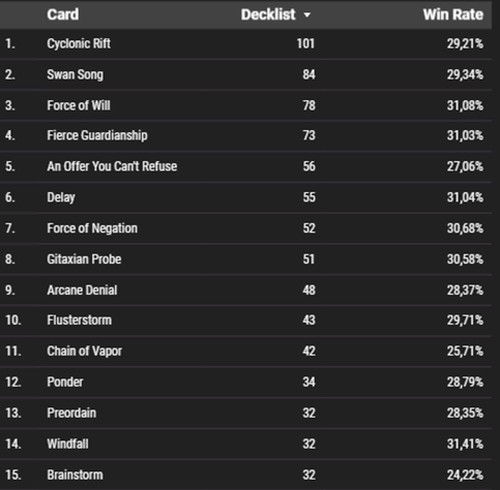
Out of the 398 card pool available in the analysis, the most commonly played Blue cards were counterspell cards. They allow the Blue player to disrupt their opponent's plans and protect their own strategy, making them a popular choice in the color. The most popular ones include Swan Song, Force of Will, Fierce Guardianship, An Offer you Can’t Refuse, Delay, Force of Negation, Arcane Denial and Flusterstorm. The rest consists of mainly cantrips and bounces, with a highlight to Cyclonic Rift as the color's most popular card.
Ad
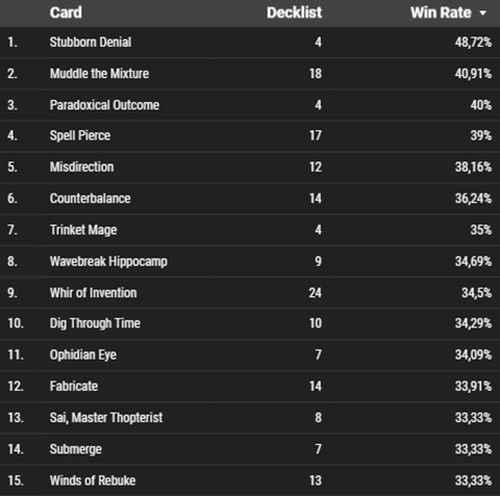
Analyzing the win rate, artifact strategies seem to work well, as here we have Paradoxical Outcome, Trinket Mage, Whir of Invention, Fabricate and Sai, Master Thopterist. That can happen because artifacts usually offer efficient win conditions for Blue decks and this is a color which has strong synergies with this category, be it through interaction or tutors.
Among counters, highlights go to: Muddle the Mixture, due to its double role as counter and tutor, and Spell Pierce, a versatile, cheap counter. We also have Stubborn Denial with the highest win rate, which shows decks in this identity which have accessible commanders with 4 or more power should stand out for this color, such as Tasigur, the Golden Fang and Rielle, the Everwise.
Black Cards
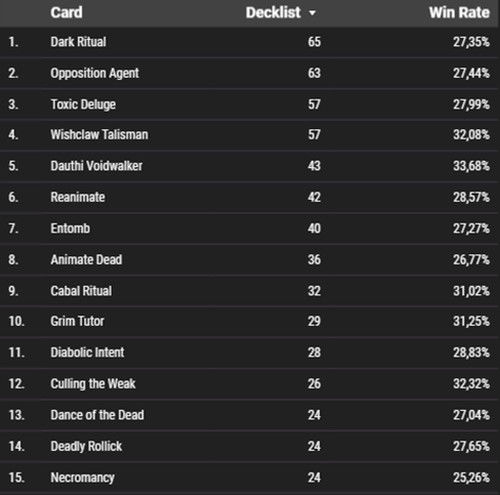
Within a popularity analysis, out of the 382 card pool, there is a strong presence of tutors, (Wishclaw Talisman, Entomb, Grim Tutor and Diabolic Intent), rituals (Dark Ritual, Cabal Ritual and Culling the Weak) and Reanimate cards (besides this card itself, there is Animate Dead, Dance of the Dead and Necromancy). Two specific Hatebears are popular: Opposition Agent (even without as high of a Tutor density as cEDH) and Dauthi Voidwalker.
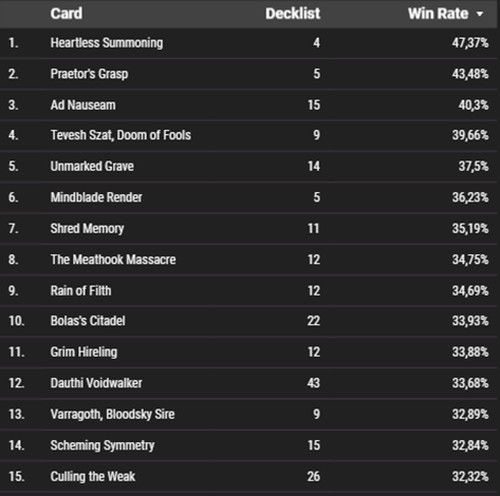
In the win rate analysis, we noticed that the increase in tutor and fast mana density seemed to be correlated with a higher win rate, probably due to the efficiency of strategies such as Farm and KCI (Krark-Clan Ironworks). The last one is the one that fits with the card with the highest win rate, Heartless Summoning.
Finally, Ad Nauseam and Bolas's Citadel were identified as the bases of more proactive decks in this color, particularly in the before mentioned Farm.
Red Cards
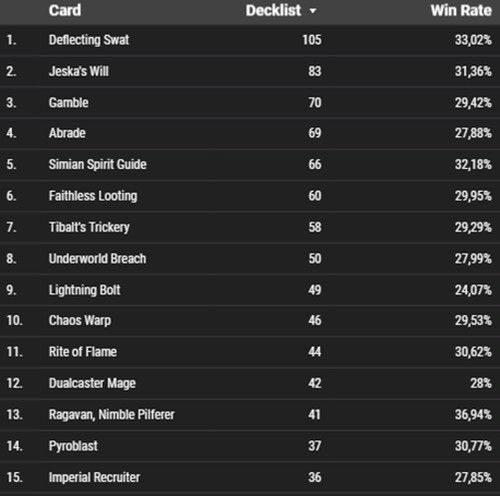
Out of the 491 card pool, there is a high prevalence of cards that provide interaction, fast mana and tutors, with highlights to Deflecting Swat, with the highest popularity by far, but still with an above-average win rate.
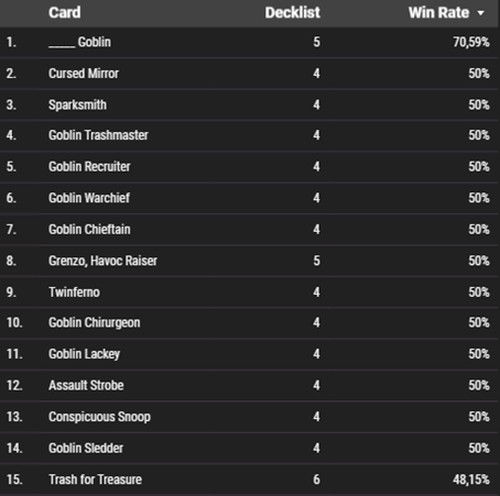
In a win rate analysis of specific cards within the Red color, we noticed the strong performance of Goblin cards, particularly in aggressive and combo-oriented decks. Muxus, Goblin Grandee and Krenko, Tin Street Kingpin considerably boost the win rates of these cards.
Twinferno and Assault Strobe stand out as options for Voltron decks in this color. Trash for Treasure was identified as a strong card in KCI decks.
Green Cards
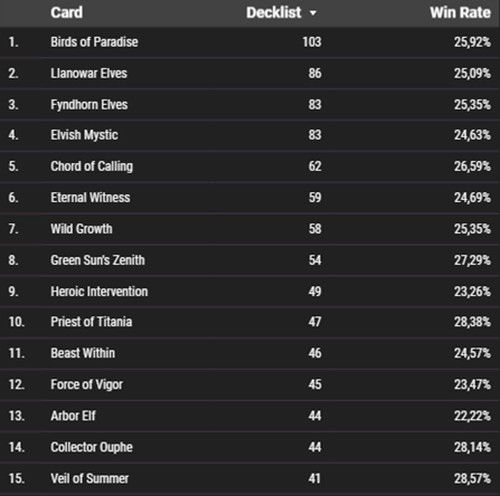
Ad
Out of the 437 card pool in Green, as expected, there is a high prevalence of cards that provide mana ramp (the top 4 positions are mana dorks), interaction with artifacts (Force of Vigor and Collector Ouphe) and creature tutors (Chord of Calling Green Sun’s Zenith).
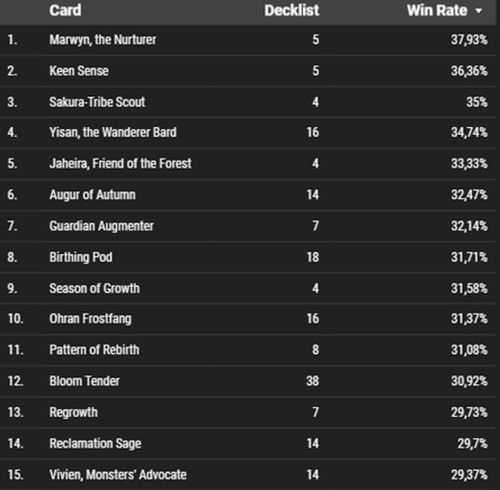
In a win rate analysis of specific cards within the color Green, one thing we noticed was the strong performance of cards that provide efficient win conditions in the form of abusable tutors (such as Yisan, the Wanderer Bard, Birthing Pod, Pattern of Rebirth and Vivien, Monster’s Advocate), besides sources of card advantage (Keen Sense, Augur of Autumn, Season of Growth, Ohran Frostfang and the before mentioned Vivien, Monster’s Advocate.
Colorless Cards
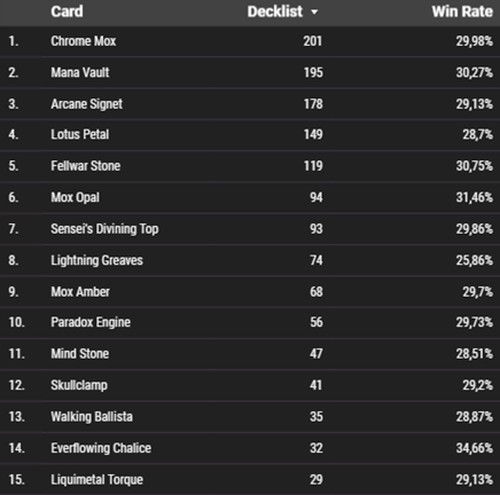
In the popularity analysis, the most played cards are mana rocks (the top 6 positions), as well as win conditions (Sensei’s Divining Top, Paradox Engine and Walking Ballista.
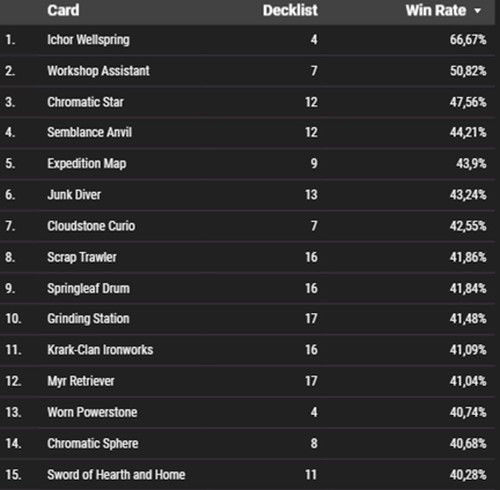
The analysis of wins of specific cads within the colorless category show the strong performance of cards that are commonly played in KCI decks (Krark-Clan Ironworks), such as Workshop Assistant, Junk Diver, Scrap Trawler Myr Retriever, and others. Cloudstone Curio and Sword of Hearth and Home perform as outliers in terms of high win rate.
Multicolored Identity Cards
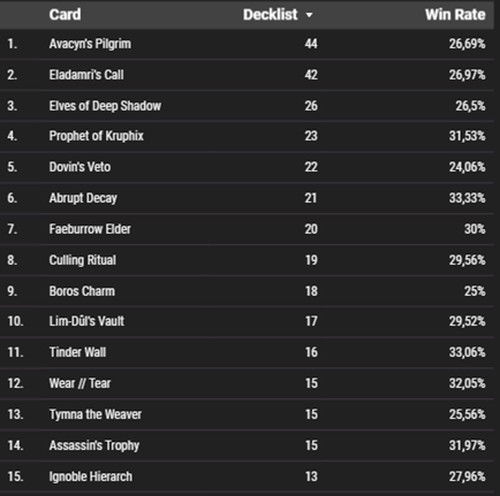
Among the multicolored identity cards, there is the high popularity of mana dorks (mana creators), as well as efficient interaction - particularly in Golgari Colors (Abrupt Decay, Culling Ritual and Assassin’s Trophy); tutors, such as Eladamri's Call and Lim-Dûl's Vault, are also commonly played. Tymna the Weaver, a powerful commander in cEDH, was also frequently used in decks.
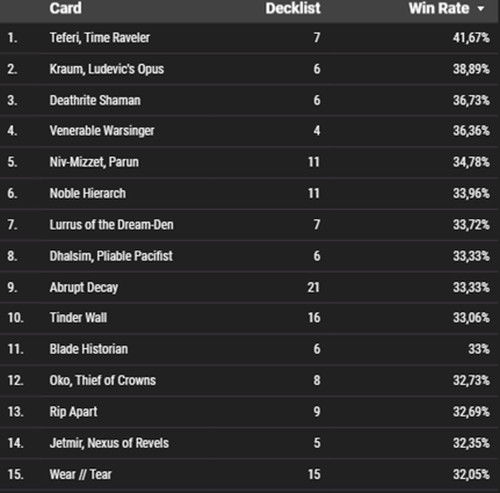
There is a strong performance of cards that provide win conditions through combo lines or combat. There is more multicolored interaction, such as counterspells and removal spells, performing well in this category.
Other Category of Cards
Win Conditions
Win conditions are a crucial part of any deck, providing the means to end the game - that is no different in Conquest and because of the cards banned, the win rates of different win conditions in the format need to be examined to check trends and patterns.
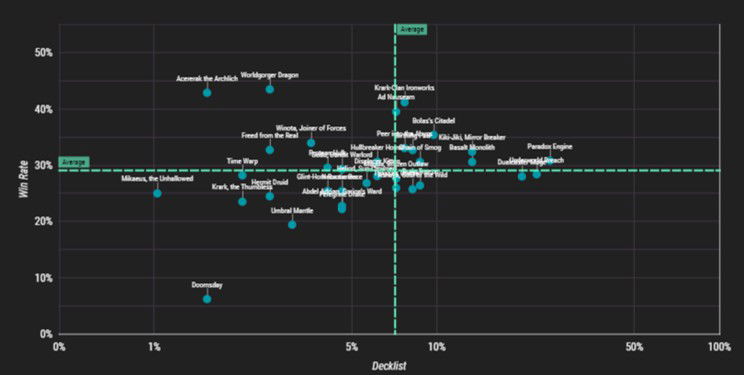
On the win rate axis, the average win rate for win conditions is 29,08%. Some standout performers include Worldgorger Dragon, which serves as a win condition for specific decks, such as Anje Falkenrath, Evelyn, the Covetous and Xantcha, Sleeper Agent, which performed well in shell Rakdos. Krark-Clan Ironworks, which has an overall strong performance in the Conquest metagame, is also well-positioned in this analysis.
Ad
Ad Nauseam, Peer into the Abyss and Bolas's Citadel have high win rates, indicating that even with 30 health, Turbo Naus or Farm strategies are still viable. The lines of Blue and Black tend to be artifact-based win conditions, such as Displacer Kitten, Hullbreaker Horror and Bolas's Citadel.
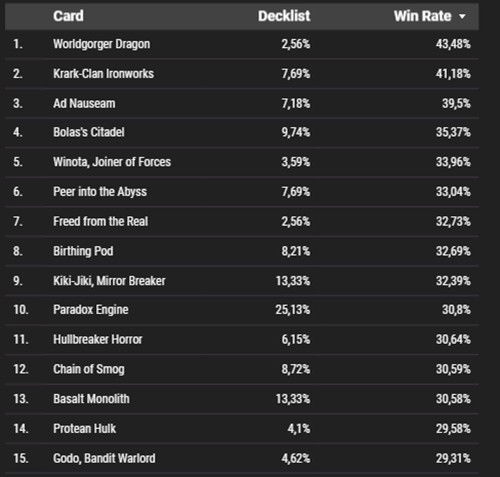
Winota, Joiner of Forces has an impressive win rate both as commander and as a win condition in decks, whereas Kiki-Jiki, Mirror Breaker is well-positioned as a win condition for RGx decks, often paired with Birthing Pod and Protean Hulk.
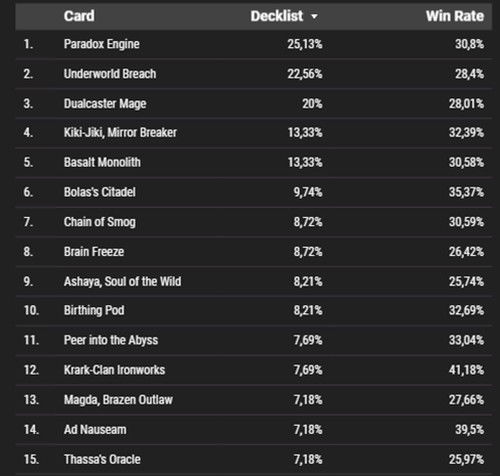
In the table, the top five win conditions are three Red-based win conditions and two colorless ones, which stresses the potential of this color in the format. On the popularity axis, though not all of them are present in this specific graph, standout performers in Red include Underworld Breach, Kiki-Jiki, Mirror Breaker, Worldgorger Dragon, Dualcaster Mage, Godo, Bandit Warlord, Magda, Brazen Outlaw and Glint-Horn Buccaneer.
White-based win conditions include Heliod, Sun-Crowned, Abdel Adrian, Gorion's Ward and Winota, Joiner of Forces. Black-based include Ad Nauseam, Bolas’s Citadel, Peer into the Abyss, Necrotic Ooze, Chain of Smog, Mikaeus, the Unhallowed, and, with Reanimator auras, Abdel Adrian, Gorion's Ward and Worldgorger Dragon. Green-based win conditions include Freed from the Real, Umbral Mantle, Ashaya, Soul of the Wild and Birthing Pod.
Fast Mana
The use of Fast Mana is a critical aspect of Competitive EDH and also Conquest, with players looking to accelerate their game plan and get ahead of their opponents. By looking through the lens of win rate and popularity, we can examine which Fast Mana cards are performing well and which are being played frequently.
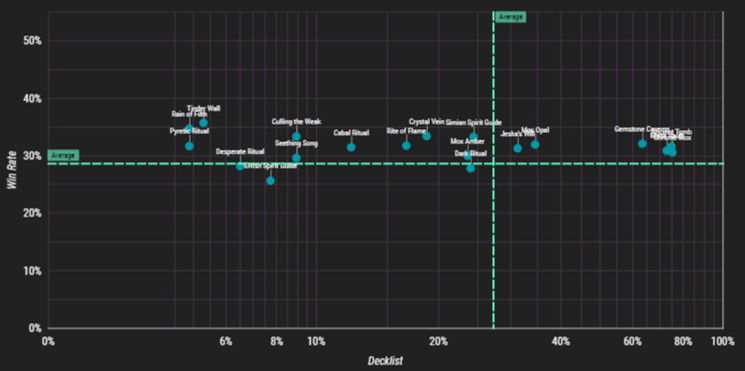
Starting with the win rate analysis, we see that the average win rate for Fast Mana cards in the Conquest metagame is currently 31,6%, which is higher than the overall average of 28,62%. This suggests that strategies with higher density of Fast Mana are generally performing well.
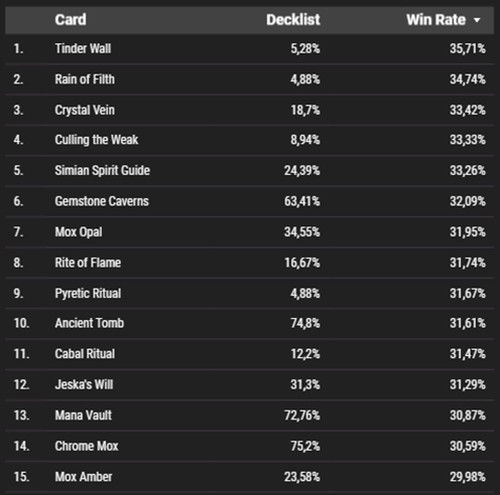
One standout performer among Fast Mana cards are those specific to Farm strategies, which have been performing well due to the success of the archetype. These cards also work well with Underworld Breach.
Dark Ritual is a surprising outlier, with a win rate significantly lower than average for Fast Mana cards. This could potentially be due to its budget nature and the fact it is played in multiple archetypes, diluting its overall performance. Elvish Spirit Guide also suffers from its association with the Green identity, which has been underperforming in the current metagame.
Ad
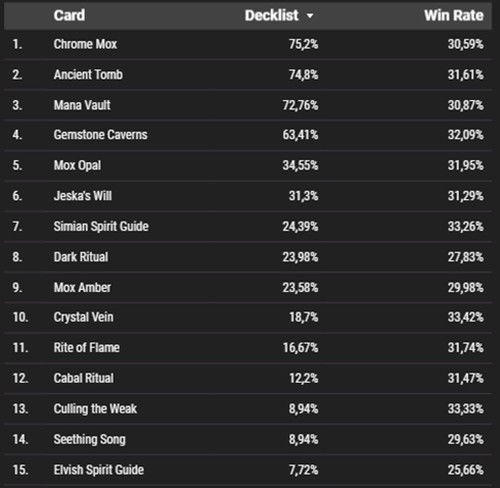
Turning back to the popularity axis, we see that all of the most popular Fast Mana cards have win rates above 30,03%, which is higher than the overall average. Generic Fast Mana artifacts and lands such as Ancient Tomb, Gemstone Caverns, Mana Vault and Chrome Mox are among the most popular, with the exception of Jeska's Will, which is a Red-based card.
Overall, Fast Mana is a valuable resource in the Conquest Metagame, and decks featuring these cards are generally more successful than those without them. Players looking to maximize their chances of victory should consider including Fast Mana in their decks.
Tutors
In examination, we can see the current state of the cards that allow players to search in their libraries through the lens of win rate and popularity, looking at which tutors are performing well and which ones are being played frequently.
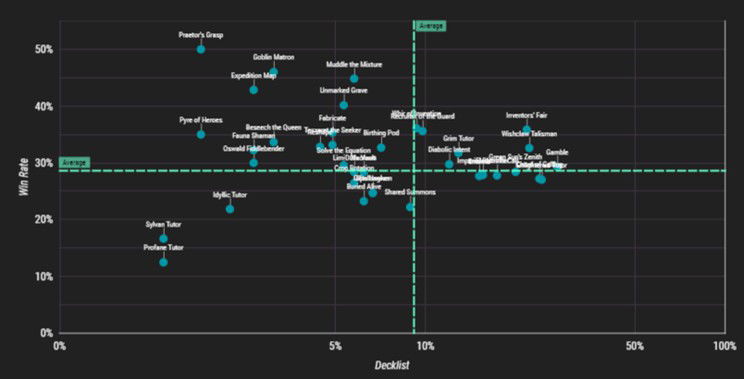
Starting with the popularity analysis, we see that tutors follow the expected "funnel" shape, with the most popular cards being those closest to the average win rate line. That suggest players generally choose tutors which are popular and successful in the metagame.
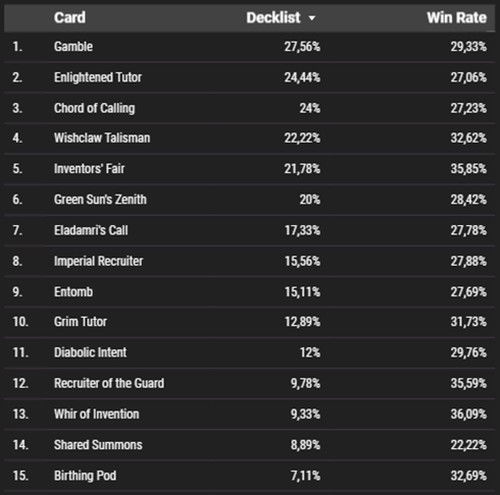
Not surprisingly, more mana efficient tutors are more popular, as they allow players to search their libraries without sacrificing too much tempo. There is a good balance of color among the most popular tutors, with all decks aiming to play with the best options available.
Turning to the win rate analysis, we see that the average win rate for tutors is currently 30,93%, which is higher than the overall average win rate of 28,62%. This suggests that tutors are a valuable resource for players looking to secure victory, and that decks featuring these cards are generally more successful than the ones without them.
Five artifact-specific tutors are among the top 15 in terms of win rate, as are four generic tutors. The most successful tutors have an average mana value of 3, indicating that players are willing to pay a moderate cost for the ability to search their libraries.
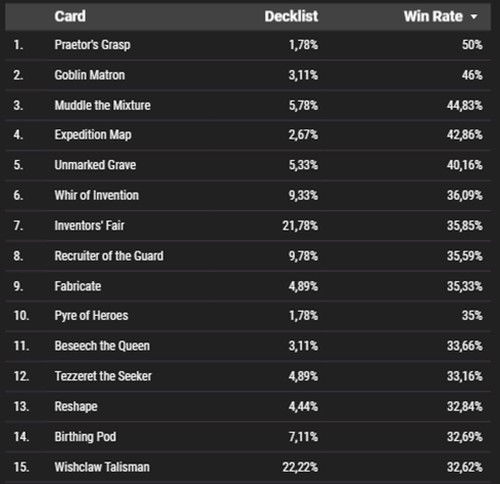
It is worth noting that the presence of tutors in a deck may be correlated to higher overall win rates. That could be due to the fact that decks with higher densities of tutors are more optimized and able to take advantage of the specific cards they need at the right times. Further research would be needed to confirm this hypothesis.
Banned Cards in Commander
In this analysis, we will be taking a closer look at the cards that are banned in Commander and examine their performance in Conquest. We will be analyzing their popularity and win rate to gain a better understanding of their strengths and weaknesses.
Ad
One thing to note is that most cards in this category do not have enough analysis volume (with at least 4 decklists) to draw conclusions. These cards include Iona, Shield of Emeria, Biorhythm, Sway of the Stars, Sundering Titan, Coalition Victory, Panoptic Mirror, Lutri, the Spellchaser and Golos, Tireless Pilgrim.
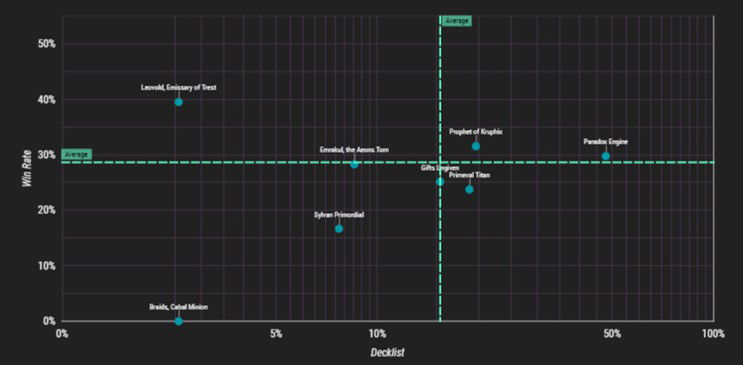
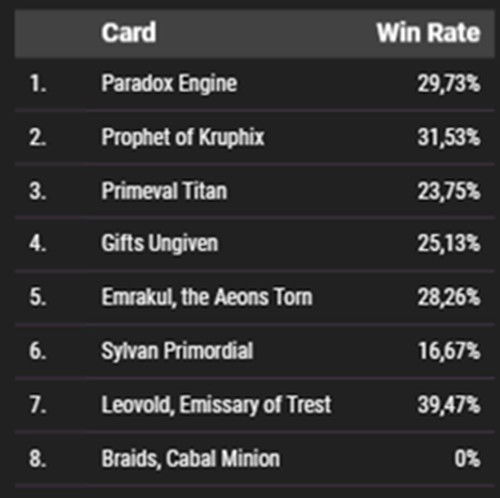
Leovold, Emissary of Trest and Braids, Cabal Minion have extreme win rates (for more and for less), but with a volume so low, it is difficult to accurately gauge their performance.
Out of the remaining cards, only two are popular and have an above-average win rate: Paradox Engine and Prophet of Kruphix. However, neither of these cards are in a particularly worrying position, as their win rates are close to the average.
Emrakul, the Aeons Torn, Gifts Ungiven and Primeval Titan all have slightly below average win rates, indicating that they can be still considered healthy in the current metagame. However, Sylvan Primordial stands out as a discrepancy among these cards, with a win rate of only 16,6%.
Conquest Watchlist
The purpose of this analysis is to carefully evaluate the cards on the Conquest watchlist, that is, the ones which the balancing committee keeps under their watch, and understand how they fare in the format.
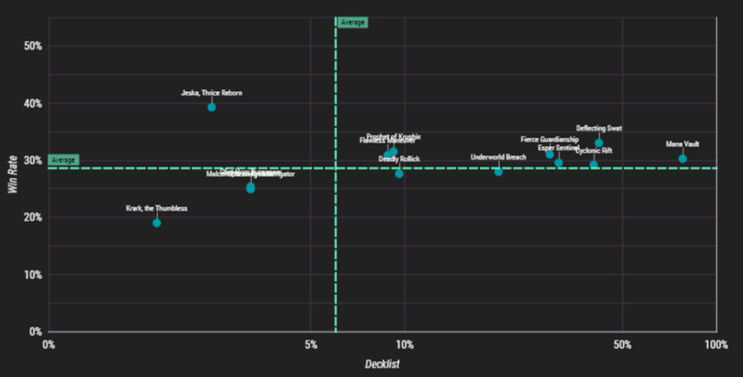
In general, the cards on the watchlist are above average in terms of win rate. The exceptions are Obscuring Haze, Deadly Rollick , Krark the Thumbless, Underworld Breach, Glint-Horn Buccaneer and Malcolm, Keen-Eyed Navigator, all with lower than average win rates. Krark the Thumbless and Jeska, Thrice Reborn have low volumes of games in the sample, but Jeska has the highest win rate at 39,29% in only 6 decklists (4 as commander).
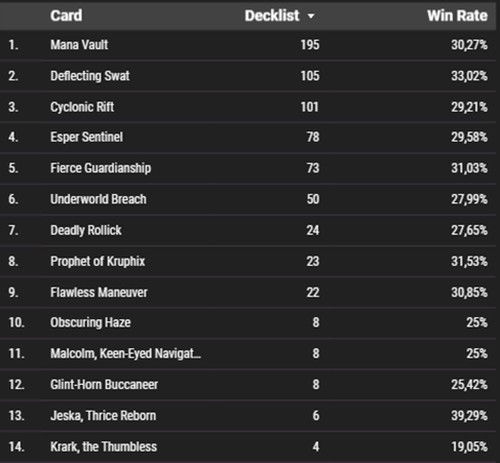
Deflecting Swat has the highest win rate among the cards on the watchlist at 33,02%, deviating from the ideal "funnel" shape, in which the majority of cards have win rates around the average. Fierce Guardianship also slightly deviates from the funnel shape, with a win rate of 31,03%.
Mana Vault is by far the most popular card on the watchlist, with 195 decklists and a win rate of 30,27%. When removing the log scale from the matrix graph, we can see that Mana Vault's popularity is more accurately reflected:
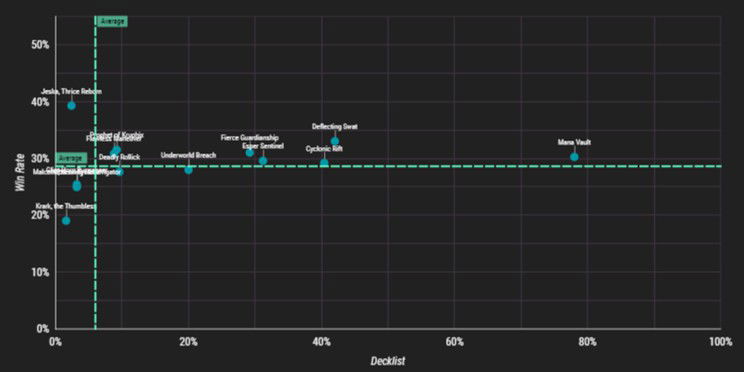
Final Thoughts
We have come to the end of the second part of our analysis. I hope this reading has provided you with new tools and perceptions regarding how to explore this format. I would like to thank my partners in this saga of collecting data and analyzing it: Rodrigo Maestrali, Rodrigo Querino, Fabrício Maia, Igor Grécia and particularly, Rony Ramos. You are amazing!
Ad
For the next and last article, I will bring an analysis regarding the archetype composition in this format, at the level of commanders and staples. Keep up with Card Realm to read it!
See you next time!
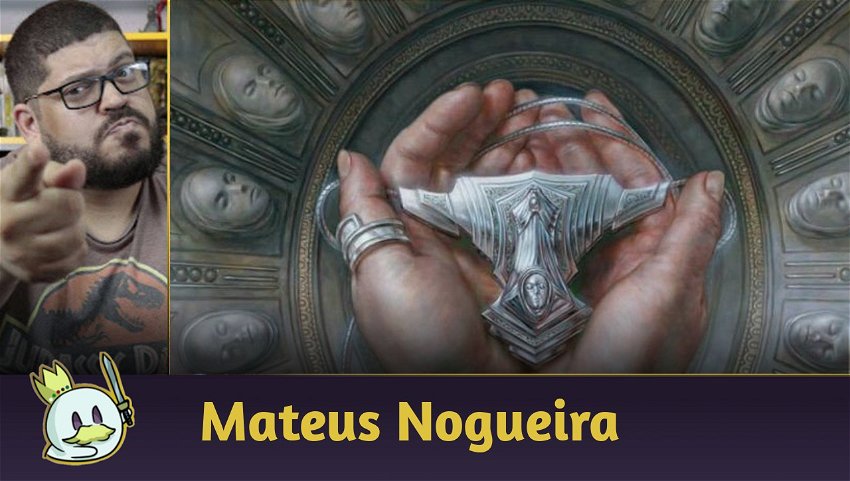



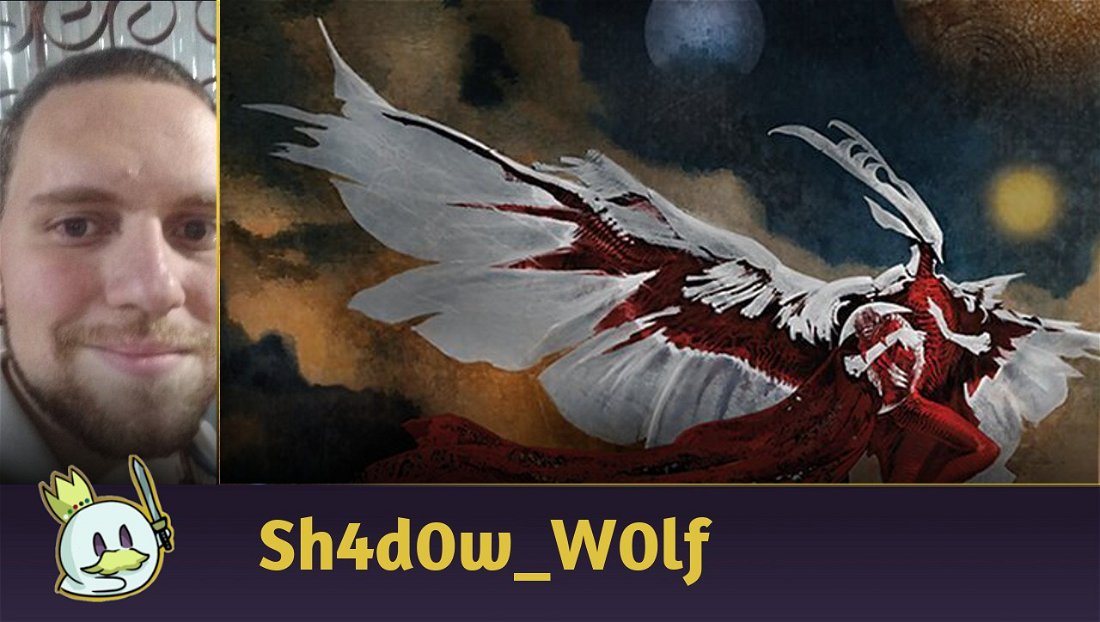
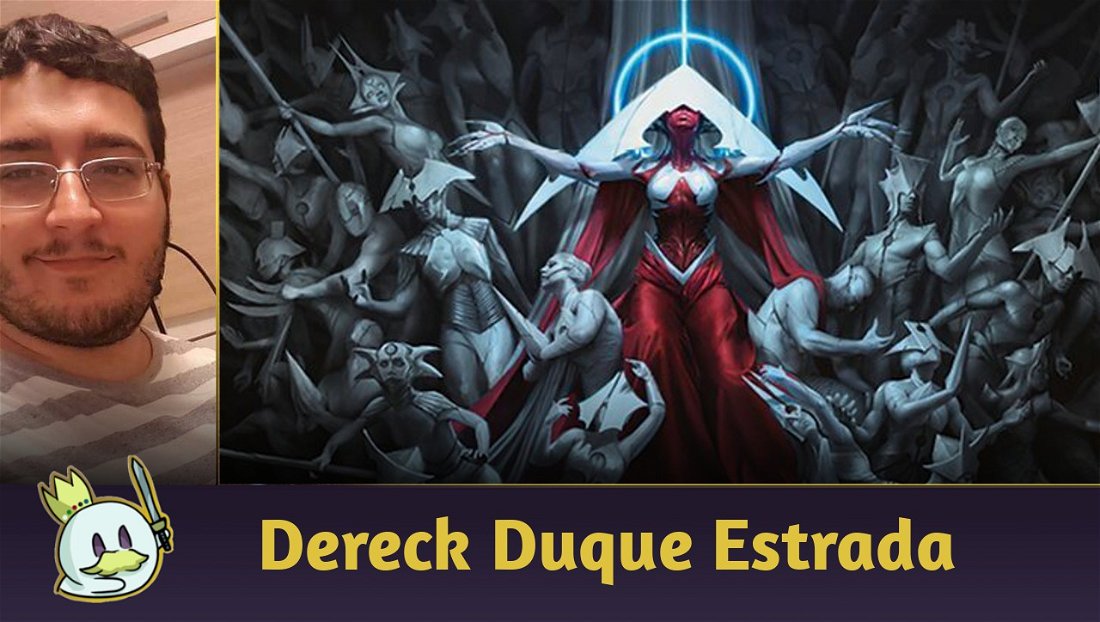



— Comentarios0
Se el primero en comentar